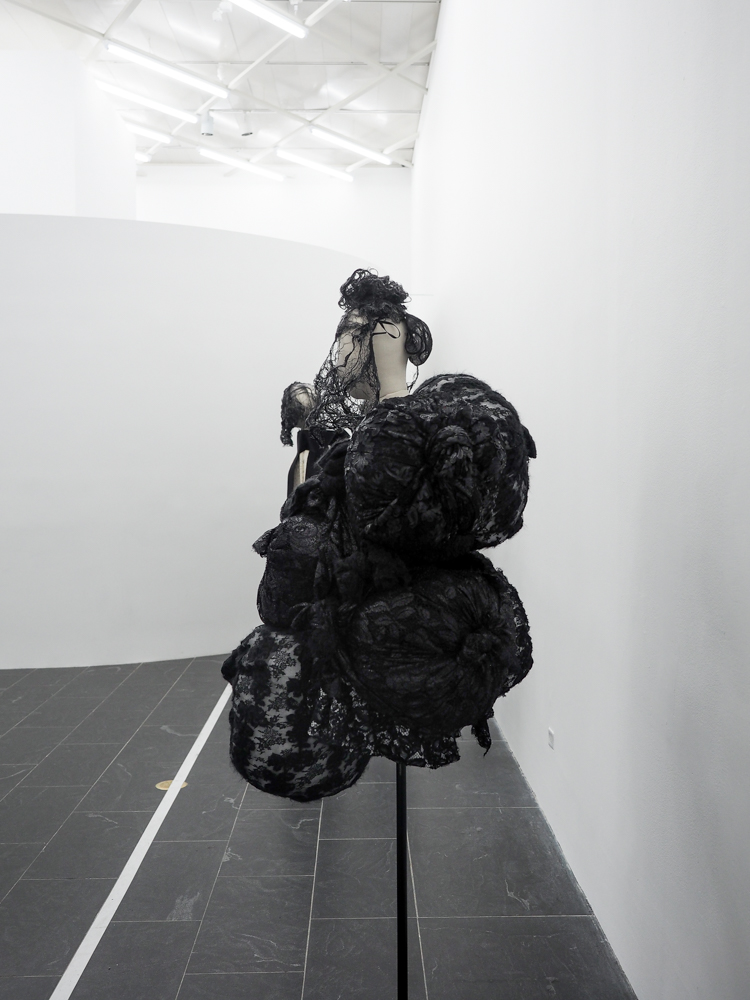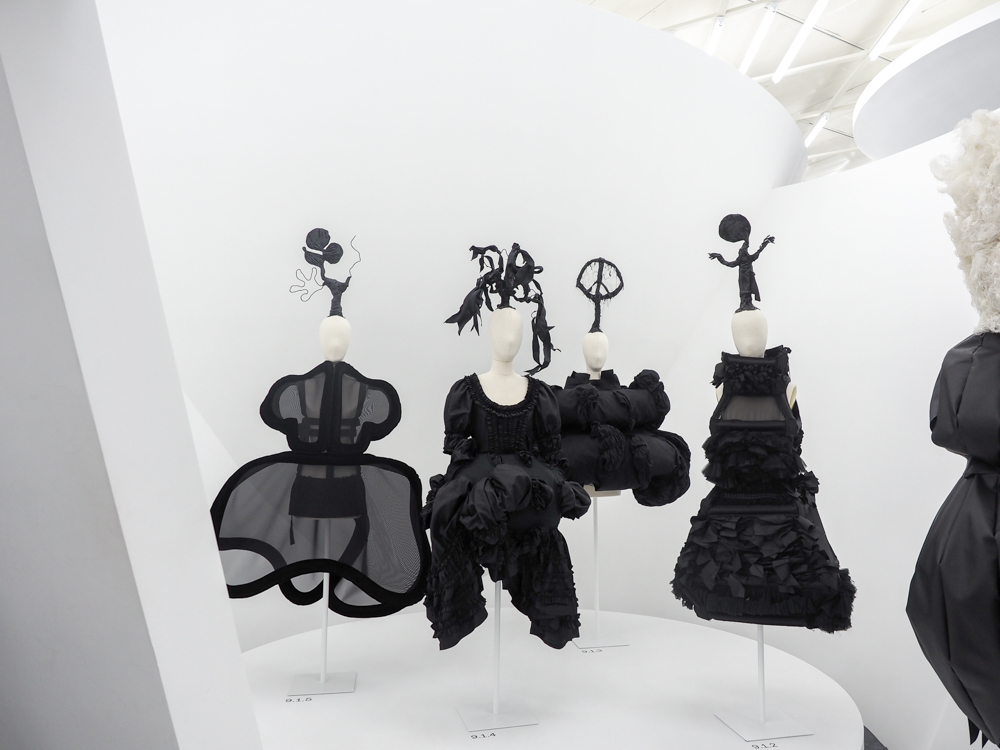Rei Kawakubo: An In-Between Life
The lights dim, shining down on a rectangular platform. A model appears, wearing sky-blue Nike sneakers and an armless, bulging dress that looks more like a gigantic cluster of wool laundry balls. She walks forward slowly, on tiptoe, as if she were taking pains to not wake a sleeping giant. A second model emerges from the void, then a third, all wearing slight variations of the woolen ball dress. They zigzag around each other in a hazy choreographed dance; when they finally depart, more models come in and out of the fold wearing outfits reminiscent of mutated paper bags and inflated space blankets. The spectacle lasts for twelve minutes until the last model remains, spinning softly on the platform until the void overtakes her and she disappears from sight.
These are not scenes from a surrealist fever dream but rather the work of Rei Kawakubo, the founder and visionary mastermind of Japanese fashion label Comme des Garcons. Of all the Japanese fashion designers working today, there are none who have achieved the legendary aura that pursues Rei Kawakubo. As the reclusive designer behind Comme Des Garcons, she paints the picture of an enigmatic avant-gardist that is as adored in the fashion industry as she is parodied outside of it. Though her designs are unconventional, her influence on contemporary fashion is everywhere: if you’ve ever worn an asymmetrical hemline, stopped by a pop-up shop, shopped in an independent department store, listened to a St. Vincent record, or dressed all in black, you probably have Rei Kawakubo to thank for it.
Taciturn and undeniably intimidating, Kawakubo has been the subject of critics’ fascination for most of her professional life. This is in large part because she dislikes talking about her work, insisting that her work ought to speak for itself. In spite of her refusal to cooperate, she’s been called fashion’s purest visionary by the New York Times, the most free-thinking of all the fashion designers by The Business of Fashion, and a cult figure in the industry by Vogue. But it was Matthew Schneier at The New York Times who said it best, stating, “Many designers work with the goal of making women look good. Ms. Kawakubo seems to work with the goal of making women look again.”
Rei Kawakubo was born in 1942 in Tokyo, the oldest of three children. She studied art and literature at Keiko University before leaving home to work in the advertising department of a textile manufacturer. After a brief period working as a freelance stylist, she launched Comme des Garcons in 1969. Comme des Garcons, which is French for “Like Some Boys”, produced women’s clothes that favored mobility over sex appeal. Voluminous and cratered with holes, the label released silhouettes that were completely detached from the mainstream power-dressing uniforms of the time. Kawakubo’s clothes developed an ardent following in the 1980s, with her devotees dubbed as “crows” in the Japanese press for the all-black ensembles they favored. By the time the label made its Paris debut in 1981, Comme des Garcons had over 150 stores throughout Japan and Kawakubo had become the de facto voice of the Japanese avant-garde. Her Paris debut was outrageously successful, with the fashion press controversially praising her “Hiroshima chic” style (so named for the chaos contained within the structured, regimented black garments). 34 years later, Comme des Garcons continues to break boundaries and expectations even as the fashion world struggles to catch up to its vision.
Comme des Garcons’s runway presentations are closer to performance art than traditional fashion show and elicit the full range of emotional responses that typically follows performance work. Her clothes can elicit wild applause, tears, bewilderment, and annoyance all in the span of twelve minutes (the usual runtime of their fashion shows). That instability suits her just fine. Though Kawakubo is in the mercurial business of making clothes, every collection she presents begins in pursuit of the new. “Doing something new doesn’t necessarily have to be beautiful in the eyes of the people who look at it,” she said in an interview with the New York Times. “The result of doing something new is beautiful. The fact of doing something new and people being moved by it is what’s beautiful.” She doesn’t expect everyone to want to wear Comme des Garcons- that is the nature of dealing in the new. “If everyone came and saw the beauty of it and tried it on and felt amazing, that’s the end,” said her husband and Comme des Garcons president Adrian Joffe. “If everybody thought it was beautiful, it would be time for Rei to stop. The times we’ve had standing ovations, when absolutely everybody loved the show, were the times she has worried the most.”
“I never meant to start a revolution,” Kawakubo told the New Yorker in 2004. “I only came to Paris with the intention of showing what I thought was strong and beautiful. It just so happened that my notion was different from everybody else’s.”
Those who had never heard of Kawakubo before were introduced to her oeuvre in the 2017 show “Rei Kawakubo/Comme des Garcons: The Art of the In-Between” at the Metropolitan Museum of Art’s Costume Institute. The show exhibited 150 Comme des Garcons ensembles, spanning a period of over 36 years of astonishing creativity. The gallery, which was designed by Kawakubo herself, was split into nine expressions of “in-betweenness” that manifest in Kawakubo’s work: Absence/Presence; Design/Not Design; Fashion/Antifashion; Model/Multiple; High/Low; Then/Now; Self/Other; Object/Subject; and Clothes/Not Clothes. The show was significant for two reasons: it would be the first time the Costume Institute had dedicated an entire show to a living designer since the French couturier Yves Saint Laurent in 1983, and Kawakubo herself would attend the Met Ball. Kawakubo, who does not make public appearances and has historically resisted museum retrospectives of her work, was eventually won over by the opportunity to present Comme des Garcons on her own terms.
For many, “Art of the In-Between” marked a significant and overdue recognition of Japan’s contributions to the western avant-garde. “She is 74 and still producing some of the most avant-garde and conceptually challenging clothes that are being produced today.” said Andrew Bolton, head curator of the exhibit, in an interview with the New York Times. Though the concepts that inspire her work are inherently Japanese (emptiness, voids, dichotomies), their unruly construction reflect a distinctly Parisian tradition of rebellion and destruction. In Kawakubo’s able hands, garment meets body, East meets West, concept meets punk, and meaning meets artificiality.
Kawakubo’s clothes may have the rigor of modernist architecture but there are loose flaps, extraneous arms, and asymmetrical edges that let the wearer improvise her own particular style of dress. It is not rare to see shredded dresses, blood-red hoods, or large bulges protruding from odd places on the “Comme” runway. The clothes look like they are designed to reject description, indeed, they seem to be deliberately constructed to confuse and repel bystanders. This act of rebellion may come off as shock theater, but it actually offers something much more compelling: distance that allows for self-expression. In avoiding trends and convention, Kawakubo’s clothes embody a clear mantra: when others do not understand you, they are unable to define you. Ultimately, it is up to you to define yourself, be it through your clothes or the things that you say. Dressing for yourself, as opposed to dressing to make others comfortable, is an act of freedom that only fashion can offer. It is telling that, for a woman who deals in the in-between, Kawakubo has never wanted to identify as an artist. Instead, when asked how she’d describe herself, she often replies with just one word: “businesswoman.”
WORDS BY MAGALI ROMAN
PHOTOGRAPHY BY KAZ MORIHATA







